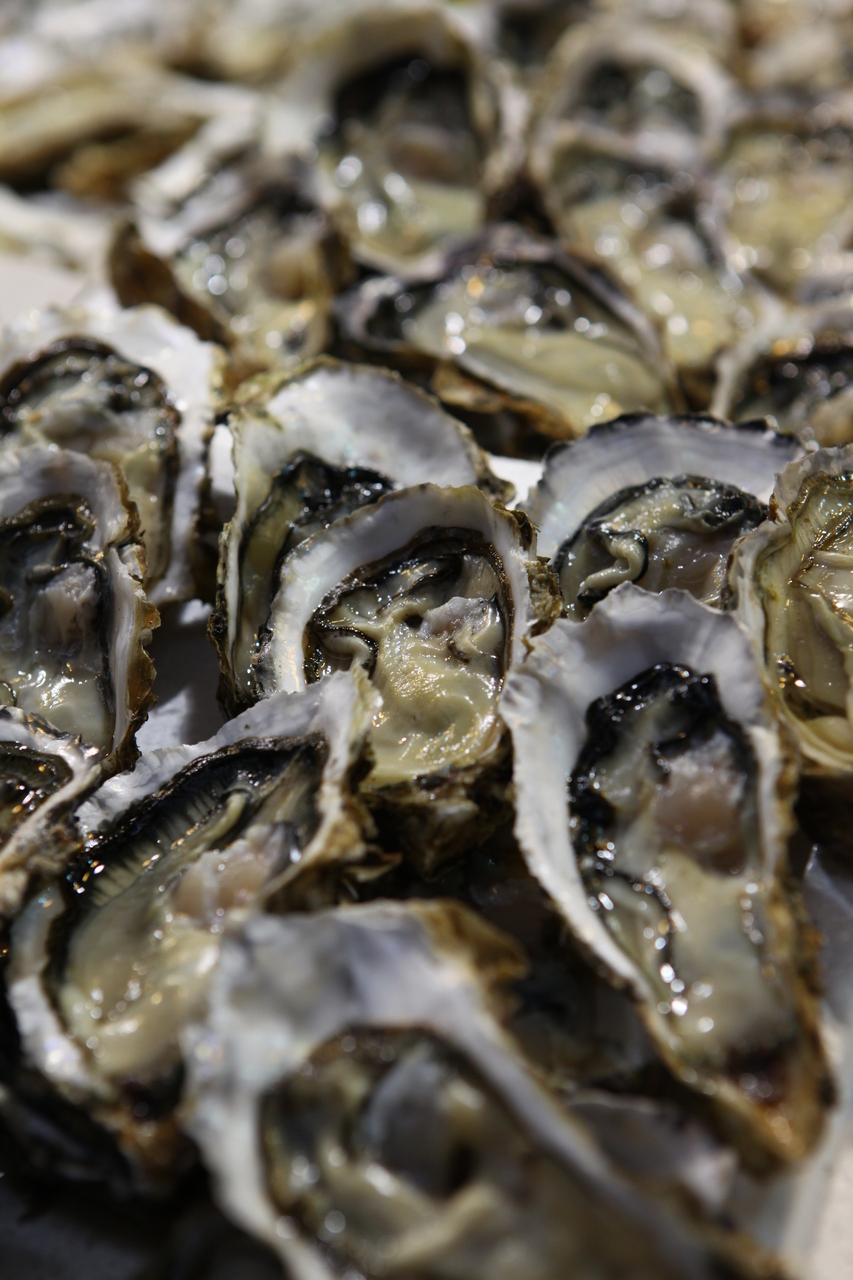
Fresh Oyster ⓒ한국관광공사 사진갤러리-이범수
Oysters are cheap in Korea.
Korea has a rich tradition of oyster cultivation and consumption due to several factors that contribute to the abundance of them in the region:
Geographical Location: Korea’s long coastline and the presence of numerous bays and estuaries provide an ideal environment for it’s farming. The combination of warm and cold ocean currents creates a diverse marine ecosystem that supports to growth.
Tidal Flats and Mudflats: Korea is known for its extensive tidal flats and mudflats along its coastlines, which serve as natural habitats for them. These areas are ideal for it cultivation and support the development of it’s beds.
Cultural Tradition: they have been an important part of Korean cuisine for centuries. They have been consumed for their nutritional value and flavor, and as a result, it’s farming has been a longstanding practice in Korean coastal regions.
Farming: Korea has a well-developed it’s farming industry. farming involves the cultivation of it’s in controlled environments, such as tidal flats, where it can feed and grow. Korean farmers have developed techniques to optimize production.
Seafood Demand: The demand for seafood is high in Korea due to the popularity of seafood in the local diet. they are used in various traditional dishes, soups, and stews, and their abundance ensures a steady supply.
Cultural and Culinary Significance: they have cultural and culinary significance in Korea, especially during the winter months when they are in season. Various traditional dishes and festivals celebrate it, contributing to their prominence in Korean culture.
Environmental Conditions: The temperate climate and suitable water conditions in Korea provide an ideal environment for oyster growth and reproduction.
Because of these factors, they are readily available and have a strong presence in Korean cuisine. The combination of coastal geography, cultural traditions, and an established it’s farming industry has made Korea one of the prominent regions for oyster production and consumption in Asia.

Nutrients
Oysters are highly nutritious and are considered a valuable source of various essential nutrients. Here are some of the key nutrients found in oysters:
- Protein: They are a rich source of high-quality protein, making them an excellent choice for those looking to meet their protein intake.
- Vitamins: They are particularly abundant in various vitamins, including:
- Vitamin B12: They are one of the best natural sources of vitamin B12, essential for nerve function and the formation of red blood cells.
- Vitamin D: They contain vitamin D, which is important for bone health, immune system function, and overall well-being.
- Minerals: They are a significant source of essential minerals, such as:
- Zinc: They are one of the richest dietary sources of zinc, which is important for immune function, wound healing, and cellular processes.
- Iron: They provide iron, a mineral essential for transporting oxygen in the blood.
- Selenium: They contain selenium, which has antioxidant properties and supports thyroid function.
- Copper: They contain copper, which is necessary for various physiological processes in the body.
- Omega-3 Fatty Acids: They are a good source of heart-healthy omega-3 fatty acids, including eicosapentaenoic acid (EPA) and docosahexaenoic acid (DHA). These fatty acids support cardiovascular health and may have anti-inflammatory effects.
- Antioxidants: Oysters contain antioxidants, such as vitamin C and vitamin E, which can help protect cells from oxidative damage.
- Phosphorus: They provide phosphorus, which is essential for healthy bones and teeth, as well as various metabolic processes.
- Selenium: They are a notable source of selenium, which is important for thyroid health and acts as an antioxidant.
- Low in Calories and Fat: Theyare relatively low in calories and fat, making them a nutritious, lean source of protein.
It’s important to note that while they are highly nutritious, they are also filter feeders and can accumulate contaminants from their environment, such as heavy metals and bacteria. As a result, it’s essential to consume oysters from reputable sources and ensure they are properly cooked or handled to minimize the risk of foodborne illnesses.
Top3 Famous Dishes in Korea
Korea offers a variety of dishes featuring that, and here are three of the most famous ones:
- Guljeon (굴전 – Pancakes): Guljeon is a popular Korean seafood pancake that prominently features it as a key ingredient. they are mixed with a batter made from flour, water, and various seasonings, and then pan-fried to create a crispy and savory pancake. It’s often served with a dipping sauce made of soy sauce and vinegar.
- Gulbap (굴밥 – Rice): Gulbap is a delicious and comforting Korean dish where fresh them are cooked with rice. The oysters are typically seasoned and mixed with rice, often flavored with soy sauce, sesame oil, and sometimes vegetables like green onions. It’s a simple yet flavorful way to enjoy the taste of them in a hearty meal.
- Gulguk (굴국 – Soup): Gulguk is a Korean oyster soup made with them, vegetables, and various seasonings. they are typically simmered in a flavorful broth along with ingredients like tofu, mushrooms, and seaweed. The result is a nourishing and savory soup with the briny taste of the oysters.
These dishes showcase the versatility of oysters in Korean cuisine and are enjoyed for their unique flavors and the taste of the sea. Oysters are often associated with the winter season in Korea, and these dishes are commonly enjoyed during that time when oysters are in season.
R-month rule
Oysters are typically considered best to eat during the months with the letter “R” in their names. This rule, known as the “R-month rule,” is a traditional guideline for oyster consumption and has historical reasons. The months without an “R” in their names are generally warmer months in many regions, and warmer waters can increase the risk of certain foodborne illnesses associated with oysters, such as bacterial contamination.
In the Northern Hemisphere, this rule translates to avoiding oysters during the summer months, typically from May to August. However, it’s essential to note that modern oyster harvesting and handling practices, along with strict regulations and refrigeration, have improved food safety and made it possible to enjoy oysters year-round without significant risk.
Many oyster enthusiasts continue to eat oysters throughout the year, even during the “non-R” months, as long as they are sourced from reputable suppliers and handled and stored properly to minimize the risk of foodborne illnesses. It’s advisable to follow local regulations and guidelines regarding oyster safety and to be cautious when consuming raw oysters, especially during warmer months when the risk of contamination may be slightly higher. Cooking oysters thoroughly is another way to reduce the risk of foodborne illness if you have concerns about consuming raw oysters.
…
…
…





